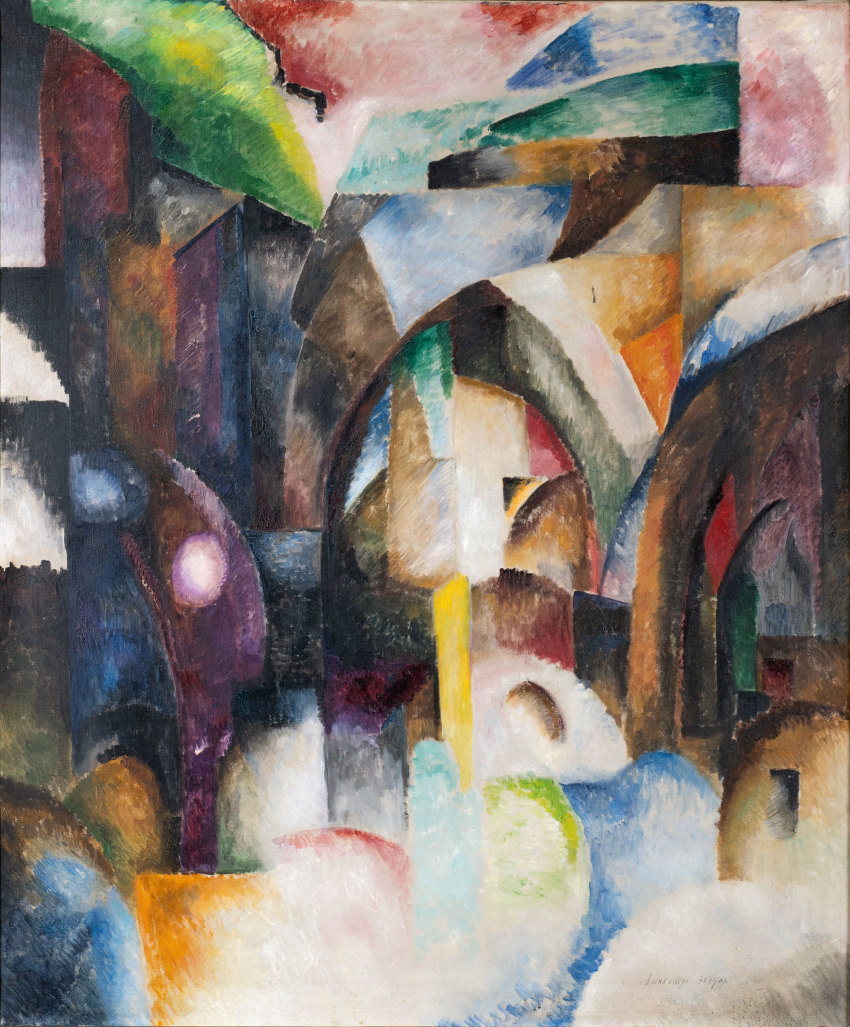Oleksandr Bohomazov, Sharpening the Saws, 1927, National Art Museum of Ukraine
Defiance is in air at the RA. It's there in the title of the exhibition: 'The Eye of the Storm'; in the bright wall colours; in the introductory explanation about the spelling of artist names. It is hard not to get caught up in the emotion when you hear that many of the works themselves are effectively refugees from the Russian invasion, smuggled to safety in the early days of the war. But when you start looking at the art, you see a different story. And when you start to unravel the history you wonder if the nationalist, self-determinist subtext is really what these works are about. The start of the twentieth century was geo-politically messy and Modernism went out of its way to be deliberately transgressive, including of state boundaries.
Thankfully, this is the RA where wall texts tend to be minimal and unpreachy and the focus is on aesthetics rather than politics. It can be frustrating, in an exhibition where most names are unfamiliar, to search round the room for the one label which gives you some basic biographical information. But ultimately the curators let the art speak for itself - and it does so, loudly and clearly. The song is one of modernism rather than nationalism but that does not make it any less compelling. These artists are a very international bunch. Sonia Delaunay is included in the show, by dint of her birth, although she was brought up in St Petersburg and was Paris-based throughout her adult career. Alexander Archipenko similarly left Ukraine for good at the age of nineteen. Many of the others travelled widely - Exter's landscapes reference Genoa and Sevres - and most spent time living, training and working in Russian territory.
The exhibition keeps trying to bring things back to nationalism and identity. There is a lot of text about folk art and traditional craft but it is not overtly reflected in the works on display. The importance of embroidery in Exter's art and her practical promotion of Ukrainian handicrafts surely deserve more attention. The section on the Kultur Lige talks about 'synthesising Jewish cultural tradition' but it is difficult to see the evidence in the swirling abstractions of El Lissitzky and Sarah Shor. And then there is the complex issue of rural life, an early twentieth century identity trope in any number of countries. Works like Oleksandr Bohomazov's Sharpening the Saws see it co-opted by the Soviet Union, bright coloured labour albeit subversively ambiguous and modernist, but the display gives little sense of earlier iterations, and consequently little context.
If you ignore the labelling, however, and focus on the visuals, this is a feast of artistic experimentation, cross-pollination and individual idiosyncrasy. The first section loosely explores different interpretations of Cubo-Futurism, from Exter's Cezanne-esque landscapes, to Bohomazov's futurist Landscape, Train and Delaunay's more familiar dreamily prismatic abstractions. Yet you also have the Burliuk brothers, Davyd's strong, chunky, expressionistic Carousel and Volodymyr's almost Munch-like Ukrainian Peasant Woman. There is a fine selection on theatre design, including Anatol Petrytskyi's witty collages of costumes for Turandot.
The second room is a mass of contradictions. Do Shor's darkly swirling abstractions - evoking the 'eye of the storm' of the title - drag us towards an abyss or evoke excitement? Either way they make me desperate to see more of an artist I have not come across. Tymofii Boichuk looks back to the future with his tempera apple pickers, all clear colours, flat lines and deceptive fairy-tale sweetness. Yasyl Yermilov's seedy relief self portrait presents the artist as a corrupt and ailing Tin Man. From there on, the inexorable slide to inevitable Soviet control and Stalinist purges hangs heavy. Petryskyi's Invalids is all grey gloom. Oleksandr Syrotenko's Rest seems like a lurid contradiction, gaudy colours no substitute for a decent meal. Semen Yoffe's In the Shooting Gallery has sinister decadence.
This is ultimately too small an exhibition, perhaps too narrowly drawn (largely from two collections) to do justice to the theme. Kazymyr Malevych seems particularly poorly represented. His sole oil painting, from 1927, showing a rural winter landscape, is contextualised well in the accompanying text, but you really want some of his earlier woodcutters and harvesters as comparison. Suprematism itself barely gets a mention. But it a sense you don't need Malevych at all - the real strength here is the showcasing of little known artists who deserve their moment in the sun. The RA deserve credit for picking up a touring exhibition about a fairly unknown bunch of painters. I suspect many people might go out of a sense of empathy or solidarity with Ukraine. But in the end, for all the quibbles about spelling, and nit-picking about geography, it is early twentieth century modernism which is on show here in all its kaleidoscopic complexity. Nationalism is not the eye of this storm.




No comments:
Post a Comment